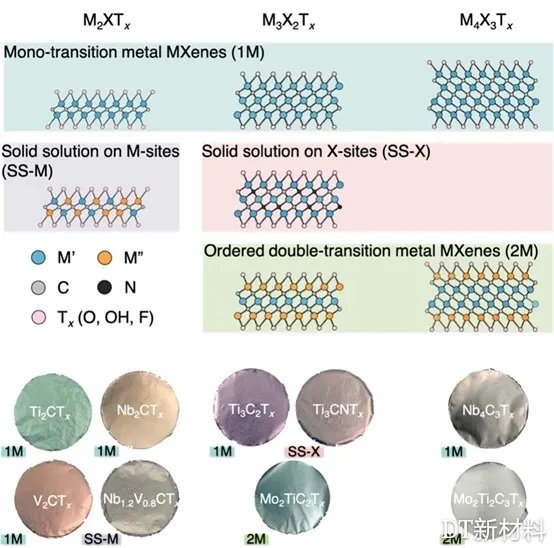 【Research Background】
【Research Background】
Since MXene appeared in Science as a high-efficiency electromagnetic shielding material in 2016, MXene‘s application in the field of electromagnetic shielding and wave absorbing has received wide attention. Among them, Ti3C2Tx film, as the material with the best shielding effectiveness, is well known and widely studied in the field of electromagnetic shielding. Although more than 30 types of MXene have been reported, studies on the effects of electromagnetic shielding effectiveness on the composition of MXene materials, the layered structure and the arrangement of transition metal atoms in the microstructure are still limited. In order to systematically study and provide as comprehensive a reference as possible, Drexel University‘s Yury Gogotsi‘s group conducted a systematic study and comparison of 16 different MXene materials, and comprehensively studied the influence relationship between the composition, structure and other factors of MXene and their electromagnetic shielding performance. The working day was published in the internationally renowned journal ACS Nano under the title "Beyond Ti3C2Tx: MXenes for Electromagnetic Interference Shielding".
[Graphic introduction]
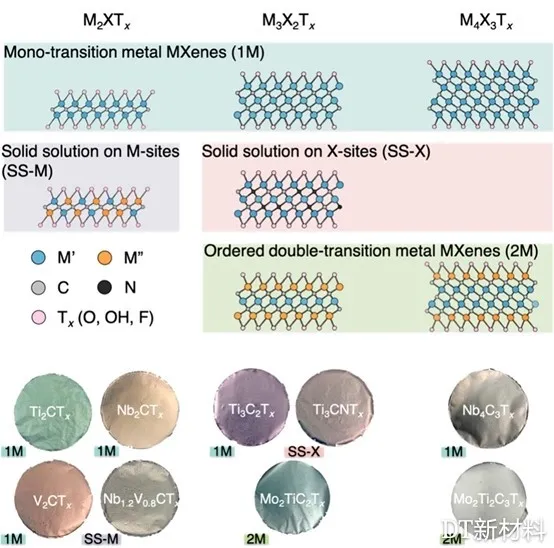
Figure 1. The MXene synthesized in the article is a schematic diagram of the MXene structure in the direction of the [110] ribbon axis.
The MXenes involved in this work can be divided into four categories, namely single transition metal MXene (1M), M position solid solution MXene (SS-M), S position solid solution MXene (SS-X), and ordered double transition metal MXene ( 2M). The electromagnetic shielding test results show that in the X-band, the shielding effectiveness of all samples decreases with increasing frequency, showing a quasi-linear relationship. This result indicates that the conductivity of MXene is frequency dependent. In addition, further comparative analysis found that for M-site solid solution MXene, its electromagnetic shielding performance can be adjusted by adjusting the ratio of different metal elements. It can be found from Figure 2h that when the value of SET is higher, the values of SER, SEA, are higher, which indicates that the electromagnetic shielding effectiveness of the MXene film is more contributed by the electromagnetic wave reflection.
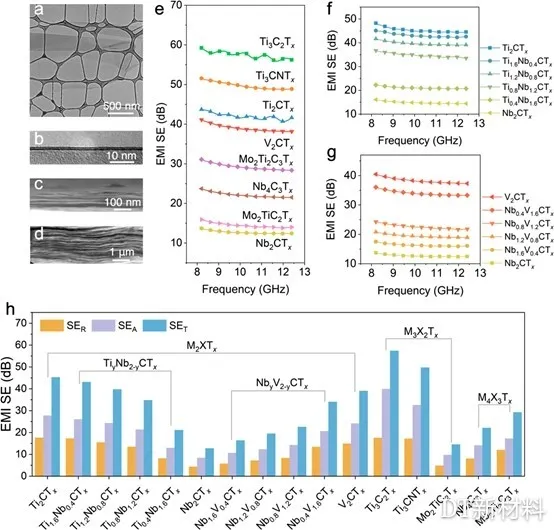
Figure 2. Schematic diagram of electromagnetic shielding effectiveness of different MXenes as a function of frequency. (A) TEM image of Ti2CTx nanosheets, (b) Cross-section TEM image of double-layer Ti2CTx nanosheets. (C) A cross-sectional TEM image of a Ti2CTx thin film prepared by spraying on a glass substrate. (D) A cross-sectional TEM image of a Ti2CTx film prepared by vacuum filtration. (E) The electromagnetic shielding effectiveness of different MXene films (M2XTx, M3X2Tx, M4X3Tx) in the range of 8.2-12.4 GHz. The sample thickness is 5 ± 0.3 μm. M-position solid solution MXene TiyNb2-yCTx (f) and NbyV2-yCTx (g) (thickness 5 ± 0.3 μm) Electromagnetic shielding performance in the range of 8.2-12.4 GHz. (h) Comparison of the average electromagnetic shielding effectiveness (SER, SEA, SET) of different MXene films (thickness 5 ± 0.3 μm) in the range of 8.2-12.4 GHz.
Because the electromagnetic shielding has a high thickness dependence on the shielding material, researchers have also conducted a systematic study on the effect of thickness. Figure 3 shows the electromagnetic shielding values of various MXene films at different thicknesses. Combining theoretical calculations and experimental measurements, it was found that both the SEA and SER values increased with increasing thickness. The MXene film prepared by suction filtration was studied and found (Figure 3d). The SET value of all MXene films increased non-linearly and monotonically with the thickness, and coincided well with the simulated conductivity value.
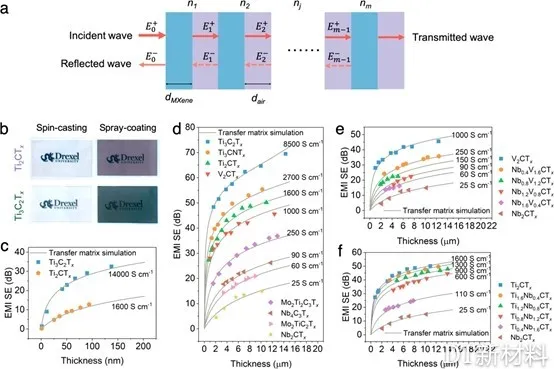
Figure 3. Different MXene film thicknesses have a significant impact on shielding. (A) Schematic diagram of the interaction between MXene and normal electromagnetic waves based on the transmission matrix theoretical model. (B) MXene (Ti3C2Tx and Ti2CTx) thin films prepared on glass substrates by spin coating and spray coating. (C) The frequency of electromagnetic waves is 10 GHz. At the time of spin coating and spraying MXene (Ti3C2Tx and Ti2CTx) films with different thicknesses, the electromagnetic shielding effectiveness obtained by theoretical simulation and experimental testing, (d) When the electromagnetic wave frequency is 10GHz, the MXene films prepared by suction filtration have different thicknesses (1- 15 μm), the electromagnetic shielding effectiveness comparison between theoretical simulation and experimental test, (e) and (f) are the comparison of the electromagnetic shielding simulation value and experimental value of NbyV2−yCTx and TiyNb2−yCTx films at different frequencies of 10 GHz, respectively. .
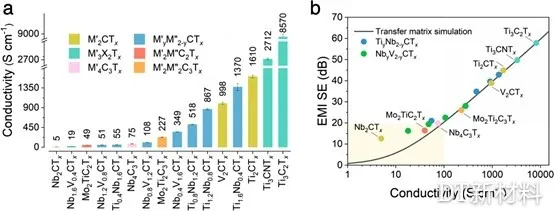
Figure 4. The relationship between electromagnetic shielding effectiveness and conductivity for different MXene samples.
The author then studied the relationship between electrical conductivity and electromagnetic shielding. Figure 4a shows the comparison of the conductivity of different types of MXene films prepared by suction filtration. It can be found that the conductivity of MXene can be adjusted by adjusting the composition of MXene. By comparing the electromagnetic shielding value obtained based on theoretical simulation with the electromagnetic shielding value measured by experiments, it can be found that when the conductivity is higher than 100 S m-1, the two have a good agreement: the electromagnetic shielding effectiveness varies with the conductivity. Linear growth. When the conductivity is lower than 100 S m-1, the experimental value is higher than the analog value, which indicates that the factors affecting the effectiveness of electromagnetic shielding are not limited to the conductivity. The author points out that this phenomenon may be due to the fact that when the conductivity is lower than 100 S m-1, the reactions such as dielectricization cannot be ignored, and the transfer matrix theory and Simon formula used by the author in the theoretical simulation process None of the effects of the mesoelectrode were considered. In addition, the above theory does not take into account the AC and DC conductivity of MXene in the X-band. Therefore, in order to further explain the application of MXene in the field of electromagnetic shielding, further research is needed.
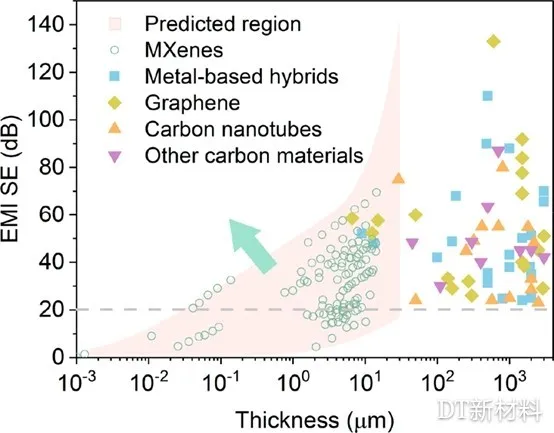
Figure 5. Comparison of electromagnetic shielding performance of different materials.
[Research Summary]
The author prepared 16 kinds of MXene materials with different compositions and structures and studied their electromagnetic shielding properties. Through theoretical simulations and experimental measurements, the authors revealed the effect of the composition and structure of MXene on the electromagnetic shielding performance of MXene. This is by far the most comprehensive research on the application of MXene electromagnetic shielding, and at the same time it provides a good guide for researchers who will study the application of MXene in the field of electromagnetic shielding.
【references】
Meikang Han; Christopher Eugene Shuck; Roman Rakhmanov; David Parchment; Babak Anasori; Chong Min Koo; Gary Friedman; Yury Gogotsi, Beyond Ti3C2Tx: MXenes for Electromagnetic Interference Shielding, DOI: 10.1021 / acsnano.0c01312
Article Source:
https://pubs.acs.org/doi/abs/10.1021/acsnano.0c01312
Source: DT New Materials


 【Research Background】
【Research Background】




